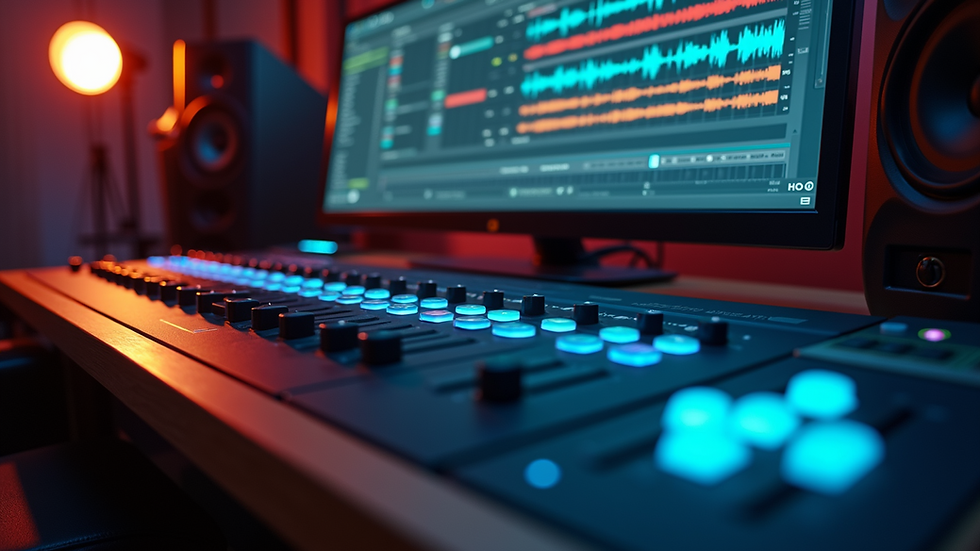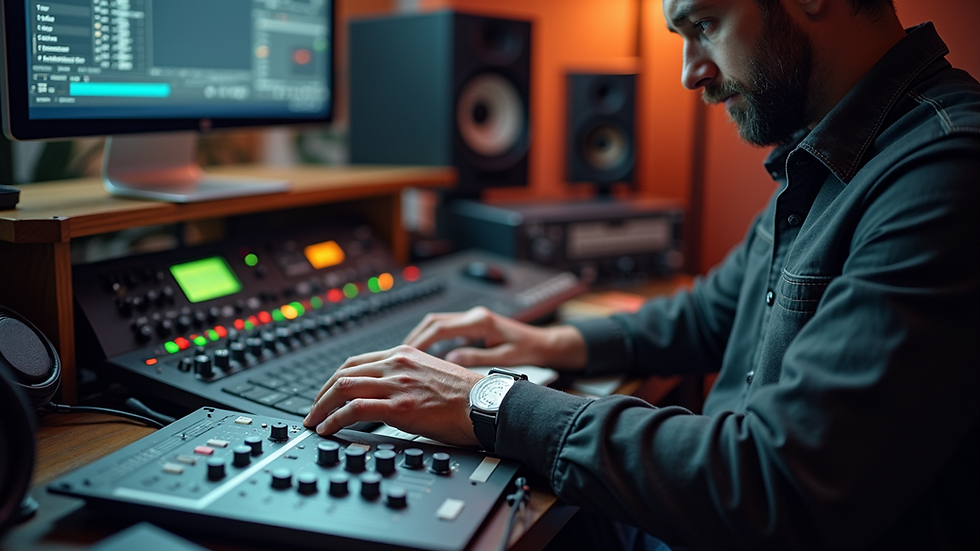“Mastering is like makeup — if you notice it, it’s probably too much.”— Tony Maserati (engineer for Beyoncé, Biggie, Alicia Keys)
- millennialsound

- Jul 24
- 5 min read
I remember the first time I tried mastering my own track — no treated room, no acoustic panels, just a pair of bright yellow KRKs and a false sense of confidence.
I bounced my mix, slapped on a limiter, cranked the gain, and thought I had it. Played it later on a Bluetooth speaker at my girl’s apartment — it sounded like cardboard… soaked in static. Empty. Harsh. Nothing stuck. That was the night I realized: loud doesn’t mean clean. Clean doesn’t mean done. I cracked open good kid, m.A.A.d city in Logic and stared at its waveform. I needed to see what “finished” looked like. That changed everything — it made me chase impact over volume.
What is Audio Mastering?
Mastering didn’t even exist as a job until magnetic tape and vinyl entered the game in the 1940s. Songs used to be cut straight onto wax cylinders. No separate mix, no polish — just performance into a horn and hope for the best. Then tape arrived post‑World War II, thanks to engineers like Major John Mullin working from German designs. Artists like Bing Crosby invested in Ampex to make it standard for radio and records. Suddenly mastering was its own job — one that shaped what the world heard.  
Engineers like Bill Putnam — “the father of modern recording” — introduced half‑speed mastering and precise EQ to make records sound clearer. That’s the foundation of what we still chase today.
Over decades, mastering evolved from tape transfer to creative craft. It’s less about fixing mixes and more about respecting them. Modern mastering engineers juggle EQ, compression, limiting, and metering to make songs translate everywhere while keeping the feeling intact.
“Mastering is not about making things louder—it’s about making them better. It’s your final chance to make everything right.”
— Doug Sax 
“Mastering is a ‘big picture’ view of a song. A mastering engineer can transfer skills across genres more easily than a mixing engineer.”
— Grammy-winning mastering instructor on Reddit 
The “Loudness War” of the 1960s‑2000s shows why this matters: albums got over‑compressed so they would sound louder than others—but often lost drama, life, and clarity. Led Zeppelin II’s hot master was so compressed it caused cartridge mistracking—and was recalled. 


Why Is Audio Mastering Important?
✅ What Mastering Looks Like Today
• Apply EQ to control frequencies—tame the mud, tame the harsh
• Use gentle compression to glue your song without killing swing
• Optional saturation to warm it up or give texture
• Limiting to lift it to streaming level without clipping
• Metered output: Aim for platform‑specific LUFS
⸻
🎛️ Tools the Masters Lean On
• Bob Ludwig, one of mastering’s legends, mastered everything from Nirvana to Daft Punk and served as mentor to modern engineers. He reminds us: if it feels right across every system, you’ve done your job. 
• Michael Graves, a five-time Grammy winner who restores historical recordings. He treats mastering like resurrection—bringing old sound back to life, not changing it. 

What is the Process of Audio Mastering?
The mastering process involves several distinct steps to transform your mixed audio into a polished final product. Here’s what you can typically expect:
Preparation of the Mix: Ensure your mix is complete and at its optimal level. Before mastering, it's crucial to leave some headroom in the mix to avoid distortion. A common practice is to have the loudest peak at around -6 dB.
Listening Environment: A professional mastering studio features a controlled environment with high-quality monitors. It's essential to listen to your track in a space where you can accurately evaluate sound.
Equalization (EQ): EQ balances the frequency spectrum. Certain frequencies may overpower others, disrupting the overall sound. By adjusting EQ settings, you can ensure clarity and presence throughout the audio.
Compression: This process controls the dynamic range of the track. It reduces the volume of the loudest parts while boosting the quieter sections. The right amount of compression leads to a more consistent overall volume without losing dynamic expression.
Limiting: Limiting is the final step that ensures your track reaches an appropriate loudness level. It prevents clipping and distortion by capping the audio's peak volume.
Exporting: Once you’re satisfied with your master, it's time to export the file. Ensure you're exporting in the correct format—different platforms may require different specifications.
For more details on the various audio mastering steps, check out this link.
Common Mistakes in Audio Mastering
Even experienced engineers can overlook important elements in the mastering process. Here are some common pitfalls to avoid:
Ignoring the Mix: If the mix is not balanced, mastering won't fix it. Always make sure the mix is in its best possible state before beginning mastering.
Over-Compression: While compression is vital for even sound, over-compressing can squash the life out of a track. Strive for a balance that maintains the track's energy.
Neglecting the Listening Environment: Always ensure you are in an acoustically treated space when mastering. External noises or poorly balanced rooms can mislead your judging of the track.
Listening Fatigue: Spending too much time mastering the same track can lead to tonal fatigue. Take breaks and come back with fresh ears to get a more accurate assessment.

Tools of the Trade
Mastering requires specific tools and software to get the best results. Here are some popular options:
DAW (Digital Audio Workstation): Software like Pro Tools, Logic Pro, or Ableton Live is essential for mastering.
Plugin Effects: There are many plugins available, including specialized EQs, compressors, and limiters. Waves, FabFilter, and iZotope are renowned for quality mastering plugins.
Monitoring Equipment: High-quality studio monitors are critical for accurate playback. Brands like Genelec or Yamaha are trusted in the industry.
Metering Tools: Metering software is essential for checking levels and ensuring you comply with loudness standards. Options like Youlean Loudness Meter or NUGEN Audio’s MasterCheck can be very helpful.
Final Tips for Successful Audio Mastering
Trust Your Ears: While tools are essential, your ears decide what sounds best. Rely on your listening skills to guide decisions.
Reference Tracks: Use professionally mastered tracks in the same genre as references. This helps ensure your track holds up against industry standards.
Get Feedback: Don’t hesitate to share your master with trusted friends or fellow musicians. Fresh perspectives can reveal aspects you might have missed.
Have Patience: Mastering is an art and can take time to perfect. Don’t rush the process; each layer of detail counts in achieving a professional sound.
By understanding the audio mastering process and implementing these practices, you can enhance your audio production skills significantly. It’s a critical step that separates amateur recordings from polished, professional tracks fit for sharing with the world.
The Road Ahead
Mastering isn’t about tools or tricks. It’s about taste, patience, and honesty.
My tracks have been mastered by people who got it—and by people who didn’t. I’ve stayed up till 3 a.m. mastering just to meet a deadline and wondered if I ruined something worth saving.
But I’ve also played masters that changed how a song felt—not just how loud it was.
That’s when I knew: mastering isn’t about getting attention. It’s about keeping it.
Keep your ears open, your software updated, and your ambitions high—your music deserves the best!

















Comments